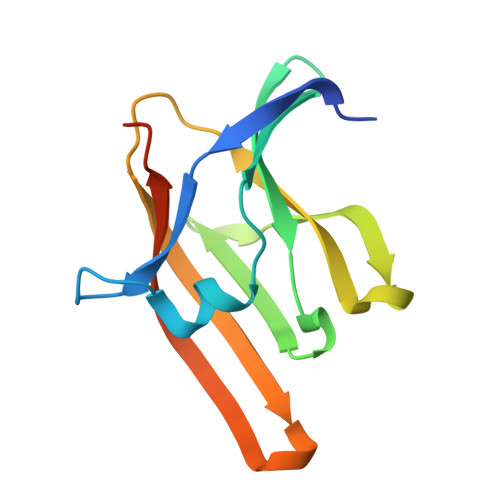Molecular basis of recognition of antibacterial porphyrins by heme-transporter IsdH-NEAT3 of Staphylococcus aureus.
Moriwaki, Y., Caaveiro, J.M.M., Tanaka, Y., Tsutsumi, H., Hamachi, I., Tsumoto, K.(2011) Biochemistry 50: 7311-7320
- PubMed: 21797259
- DOI: https://doi.org/10.1021/bi200493h
- Primary Citation of Related Structures:
3QUG, 3QUH - PubMed Abstract:
Antibiotic resistance is increasingly seen as a serious problem that threatens public health and erodes our capacity to effectively combat disease. So-called non-iron metalloporhyrins have shown promising antibacterial properties against a number of pathogenic bacteria including Staphylococcus aureus. However, little is known about the molecular mechanism(s) of action of these compounds and in particular how they reach the interior of the bacterial cells. A popular hypothesis indicates that non-iron metalloporphyrins infiltrate into bacterial cells like a "Trojan horse" using heme transport systems. Iron-regulated surface determinant (Isd) is the best characterized heme transport system of S. aureus. Herein we studied the molecular mechanism by which the extracellular heme-receptor IsdH-NEAT3 of Isd recognizes antimicrobial metalloporphyrins. We found that potent antibacterial porphyrins Ga(III)-protoporphyrin IX (PPIX) and Mn(III)-PPIX closely mimicked the properties of the natural ligand heme, namely (i) stable binding to IsdH-NEAT3 with comparable affinities for the receptor, (ii) nearly undistinghuishable three-dimensional structure when complexed with IsdH-NEAT3, and (iii) similar transfer properties to a second receptor IsdA. On the contrary, weaker antibacterial porphyrins Mg(II)-PPIX, Zn(II)-PPIX, and Cu(II)-PPIX were not captured effectively by IsdH-NEAT3 under our experimental conditions and displayed lower affinities. Moreover, reduction of Fe(III)-PPIX to Fe(II)-PPIX with dithionite abrogated stable binding to receptor. These data revealed a clear connection between oxidation state of metal and effective attachment to IsdH-NEAT3. Also, the strong correlation between binding affinity and reported antimicrobial potency suggested that the Isd system may be used by these antibacterial compounds to gain access to the interior of the cells. We hope these results will increase our understanding of Isd system of S. aureus and highlight its biomedical potential to deliver new and more efficient antibacterial treatments.
Organizational Affiliation:
Medical Proteomics Laboratory, Institute of Medical Science, The University of Tokyo, Minato-ku, Tokyo 108-8639, Japan.

















